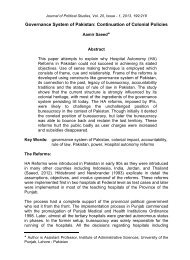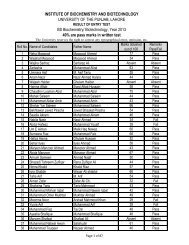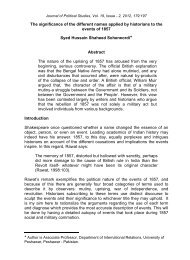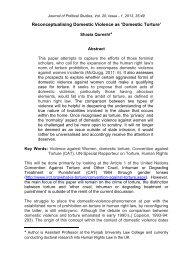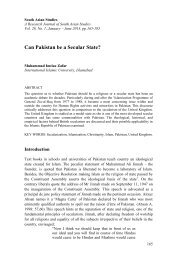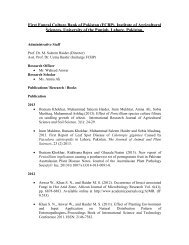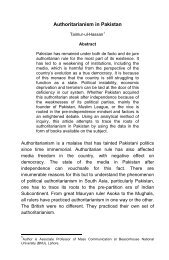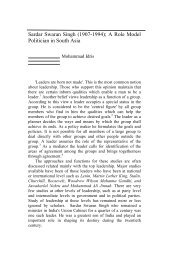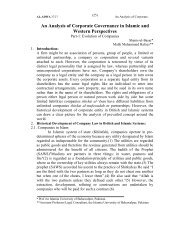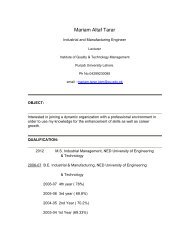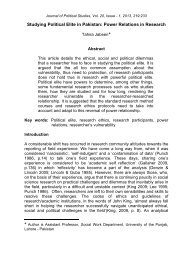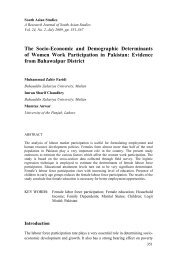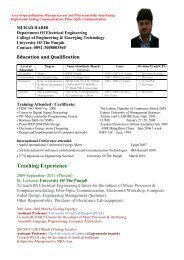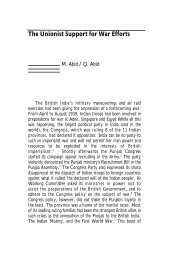pakistan geographical review 1954 - University of the Punjab
pakistan geographical review 1954 - University of the Punjab
pakistan geographical review 1954 - University of the Punjab
You also want an ePaper? Increase the reach of your titles
YUMPU automatically turns print PDFs into web optimized ePapers that Google loves.
oats are built. The whole length <strong>of</strong> <strong>the</strong> Bunder Road is one <strong>of</strong> steady activity.<br />
Behind <strong>the</strong> shops and ware-houses which face <strong>the</strong> river bank lies <strong>the</strong> new town<br />
curling round <strong>the</strong> hills with its high fiat-topped houses packed close toge<strong>the</strong>r.<br />
Beyond it on <strong>the</strong> north-western extrimity <strong>of</strong> <strong>the</strong> town is an area where a few<br />
factories, <strong>the</strong> railway work-shop, power house, water-works and large railway<br />
colony are established.<br />
POPULATION<br />
So far as <strong>the</strong> population <strong>of</strong> this town is concerned hardly any thing can<br />
be ascertained earlier than 1872, as no records are available. The first <strong>of</strong>ficial<br />
census <strong>of</strong> <strong>the</strong> town was made in <strong>the</strong> year 1872 and its population was estimated<br />
at 13,318 persons.<br />
The following table gives <strong>the</strong> estimated figures <strong>of</strong> population from<br />
1872 to 1951.<br />
1872 18RI 1891 1901 Hlll 1921 1931 1941 1951<br />
13,318 27,389 29,302 31,318 35,294 42,759 69,277 66,649 77,026<br />
From <strong>the</strong> above table it is clear that <strong>the</strong> population <strong>of</strong> <strong>the</strong> town increased<br />
nearly by six times within 80 years. The increase in <strong>the</strong> first twenty years<br />
from <strong>the</strong> date <strong>of</strong> <strong>the</strong> first census is evidently connected with <strong>the</strong> opening<br />
<strong>of</strong> <strong>the</strong> railway from Kotri to Sukkur and from Rohri to Khanpur in <strong>the</strong><br />
year 1878; <strong>the</strong> construction <strong>of</strong> <strong>the</strong> Lansdown Bridge in <strong>the</strong> year 1889, which<br />
connected <strong>the</strong> town with several o<strong>the</strong>r important towns <strong>of</strong> Nor<strong>the</strong>rn India.<br />
Railways gave a good chance for many traders to come and settle here. The<br />
policy <strong>of</strong> <strong>the</strong> early administration was also to develop Sukkur as a market town.<br />
In <strong>the</strong> next thirty years <strong>the</strong> increase is connected to many economic events <strong>of</strong><br />
<strong>the</strong> region, when <strong>the</strong> opening <strong>of</strong> <strong>the</strong> Railway work-shop and a few industries<br />
threw open jobs to <strong>the</strong> un-skilled population. Secondly, <strong>the</strong> improvement on<br />
<strong>the</strong> old canal system increased <strong>the</strong> agricultural productivity, and in 1921 it was<br />
a fairly important market town in Nor<strong>the</strong>rn India and <strong>the</strong> majority <strong>of</strong> <strong>the</strong><br />
population was engaged in <strong>the</strong> grain trade. In 1931 <strong>the</strong> population <strong>of</strong> <strong>the</strong> town<br />
increased by five times due to <strong>the</strong> construction <strong>of</strong> <strong>the</strong> Barrage, which employed<br />
thousands <strong>of</strong> workers. Latter on <strong>the</strong> Barrage town-ship was also added, which<br />
is in fact a colony <strong>of</strong> <strong>the</strong> employees <strong>of</strong> <strong>the</strong> Irrigation Department. In 1941 <strong>the</strong><br />
population for <strong>the</strong> first time showed a decline, which was due to a large fall<br />
in <strong>the</strong> number <strong>of</strong> people working as ordinary labourers who had to leave, when<br />
<strong>the</strong> Barrage was completed. The increase shown in 1951, is due to <strong>the</strong> great<br />
54



